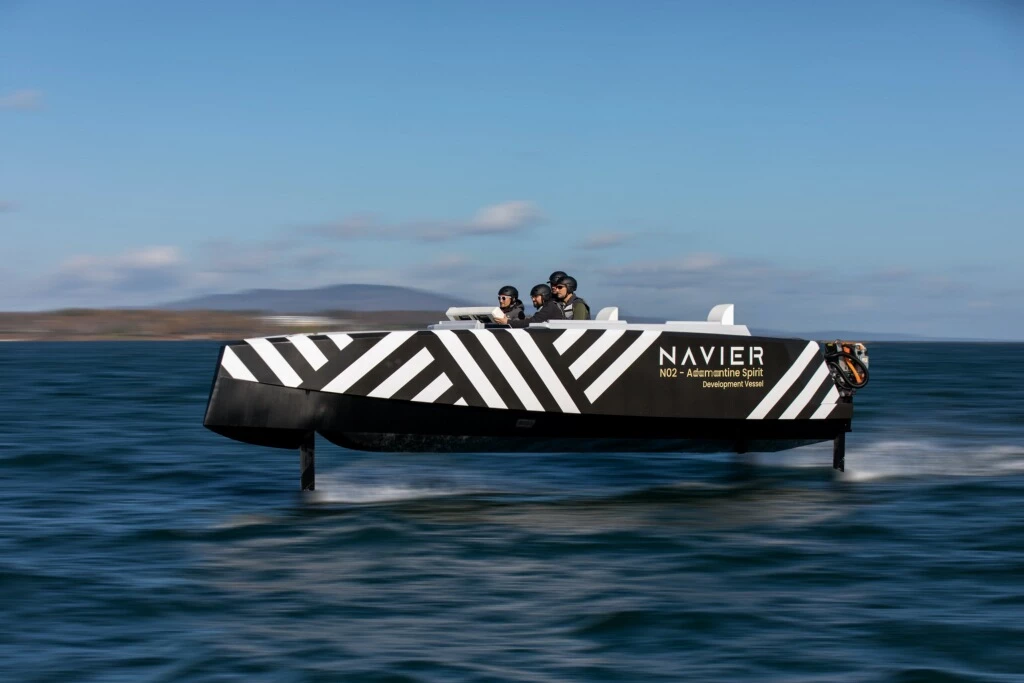Conceived to be the "boat of the future," the all-new Navier 30 adds a little length over the Navier 27 concept that preceded it while remaining true to the vessel's ambitious high-tech approach. It will deliver nearly double the all-electric range of a Candela P-8 Voyager e-hydrofoil while offering such features as a semi-autonomous autopilot system meant to evolve into full autonomy and an aerospace-derived active foil system that lets it breeze over 4-foot (1.2-m) waves. The N30 is now more than just computer renders, too, having officially debuted in Miami.
San Francisco-based Navier introduced both itself and its ambitious plans just last year, moving swiftly through prototype development and testing to reveal the Navier 30 this past week. The new 30-footer (9.1-m) represents the reworked vessel that will begin rolling out to customers next year. Despite packing on an extra 3 ft (910 cm) of length, the Navier 30 looks largely the same as the Navier 27, with the exception that the rear hydrofoils feature individual wings rather than a shared single wing. Navier has also added a sleek, open-console option to the hardtop and full cabin variants. The N30 carries up to 10 people.

Like a number of other shipbuilders and startups, Navier believes the immediate future of sustainable boating lies in electric drive technology paired to a hydrofoil system. It estimates its hydrofoils empower up to 90% more efficiency than a similarly sized vessel could get without them. Propulsion comes from rear-foil-integrated propellers driven by dual 90-kW electric motors.
Navier claims that the efficiency-boosting advantages of the hydrofoil-based e-drive give the N30 the same 75 nautical miles (139 km) of electric range it originally estimated for the N27. Those who don't plan to cruise for the full mileage can crank it up from the 20-knot (37-km/h) cruising speed to a 35-knot (65-km/h) top speed.

The Navier 30 outranges other similarly sized long-range electric hydrofoils, including the 40-NM Edorado 8S, 57-NM Candela C-8 and 60-NM Artemis. It's designed to charge overnight using a marina's 240-V hookup or in as little as 30 minutes using a DC fast charger. Navier plans to introduce a vessel with 100 NM (185 km) of range next year.
Just as impressive as the N30's range-boosting all-electric performance is its software suite, which Navier aims to make the industry benchmark. The advanced autopilot system helps ease the driver's job, assisting with features like hazard alert, collision detection and waypoint following. At the end of the day, the N30 docks easily, using either the manual joystick or a single-click automated docking system. Navier plans to continually improve the software via OTA updates, saying it expects to eventually provide full self-driving capability.

"It is important to understand this boat functions and operates more like an airplane," explains Sampriti Bhattacharyya, Navier founder and MIT PhD. "We’re rethinking the boat from the ground up, with software at the core, enabling us to deliver a vessel that is highly differentiated on customer experience and performance (efficiency)."
Of course, not every boat captain wants to immediately hand the reins over to the algorithms, so they can select from three different ride modes. Eco mode offers the most efficient ride and best range; Comfort mode delivers a smooth, easygoing ride; and Sports mode maximizes speed and dynamism. Sports mode also pares back automation in favor of manual input, including three-axis control and the ability to perform maneuvers like skid turns.

Navier held the N30's world premiere at Art Basel Miami Beach on Friday and plans to deliver the first customer boats in Q3 2023. The 2023 Edition is sold out, but the 2024 Edition is now available for reservation for a $1,000 refundable deposit. Navier doesn't list pricing, but Forbes reports that the 30 starts at US$375,000.
Source: Navier



















